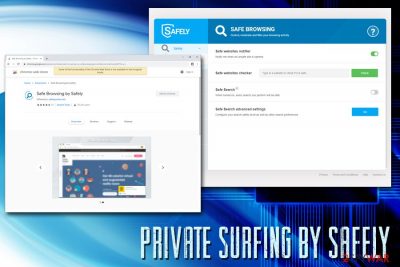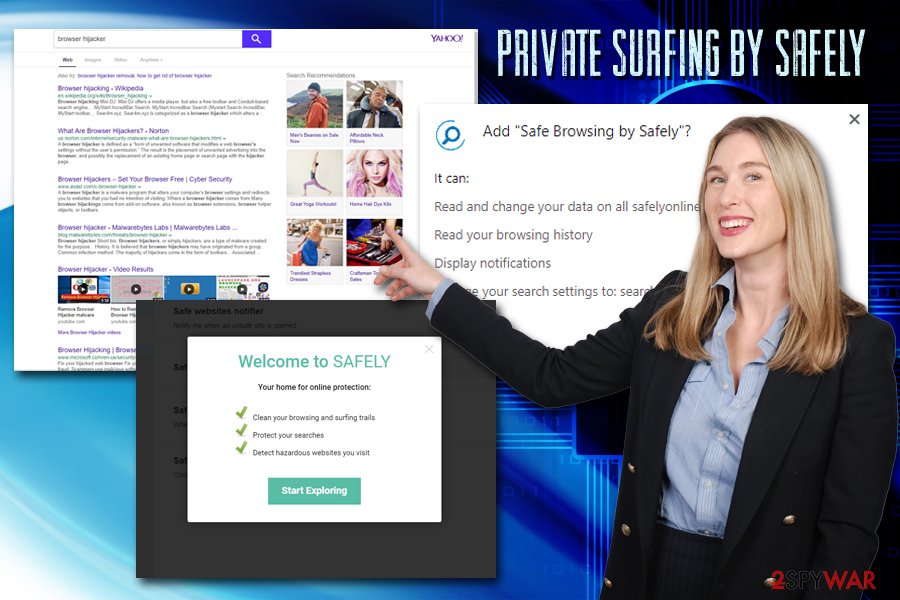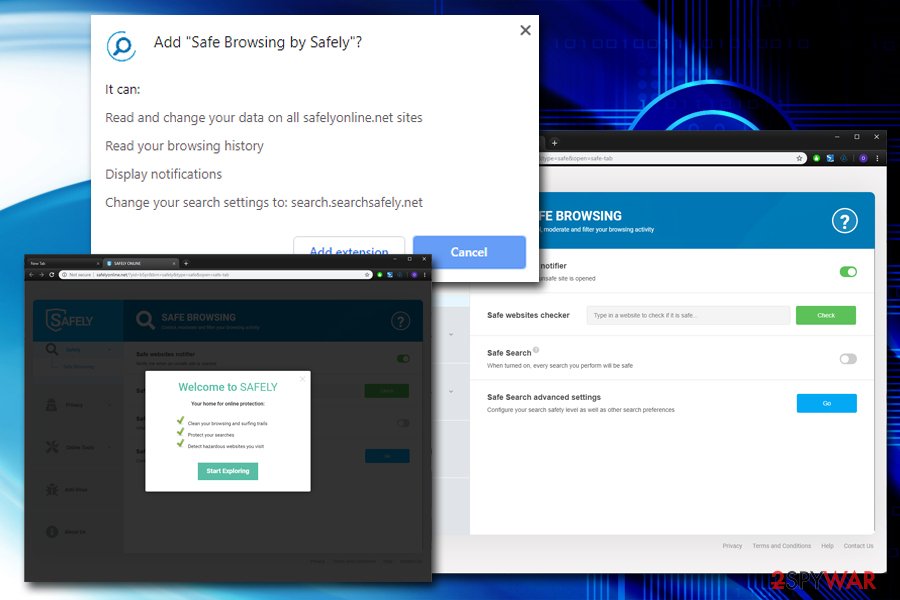Private surfing by Safely (Virus Removal Instructions) - Free Guide
Private surfing by Safely Removal Guide
What is Private surfing by Safely?
Private surfing by Safely is a browser hijacker that may disclose your personal information to its affiliates and other parties

Private surfing by Safely is a potentially unwanted program that attaches itself to Google Chrome, Mozilla Firefox, Safari, Internet Explorer, or another browser. While the extension can be installed intentionally via official sources like Chrome web store,[1] users notice the changes on their browsers after the installation of freeware or shareware (bundled software contains optional components that are hidden inside the installation wizards).
As soon as Private surfing by Safely hijack occurs, it sets the new tab address, homepage and the search engine to a predetermined one and redirects all the searches to Yahoo. However, unlike organic search results that the original search engine would bring, users will see various sponsored links and promotions.
While Private surfing by Safely claims it can help you to surf the internet safer and protect from various information gathering, its developers track plenty of data which also includes personally identifiable information. Additionally, this data is later shared with affiliates and other parties, making it a hardly reliable application when it comes to online privacy.
| Name | Private surfing by Safely |
| Type | Browser hijacker |
| Category | Potentially unwanted program |
| Installation | Software bundles, official sites, third-party sites |
| Symptoms | Altered homepage, search engine, and new tab functionality; search results filled with sponsored links, redirects to suspicious sites, etc. |
| Termination | To delete a potentially unwanted program scan your device with anti-malware software and FortectIntego, or use our manual guide below |
There are plenty of similar applications that claim to protect your privacy, but in reality, harvest and share it themselves, which is quite hypocritical. Unfortunately, users rarely check the Privacy Policy of such programs and never know that unknown parties know a lot about them. For example, Private surfing by Safely explains the following in its Privacy Policy:[2]
Usage Information is generally non-identifying, but to the extent Usage Information may be associated with you as a specific and identifiable person (for example, because you have registered for the Service) and thereby provided us with personal information (such as name, e-mail address, telephone number or home address) we treat such information as “Personal Information” and will only use it for the purposes described in this Privacy Policy.
In order to collect the data, Private surfing by Safely can use a variety of technologies:
- Cookies
- Log files
- Pixels
- Analytics[3] services
Information gathering has become one of the most vital factors when it comes to lucrative advertisement business. However, you should be aware that their data is being stored by third parties and should take adequate steps to remove Private surfing by Safely and similar search engines that pretend to care about online safety.

If you struggle with Private surfing by Safely removal (which might be the case, as some potentially unwanted programs might persistent and return with the intrusive content), you should scan your computer with anti-malware software and FortectIntego – this will ensure that you eliminate all the unwanted apps thoroughly.
Be aware that unwanted programs can enter your computer during the installation of free apps
As we previously mentioned, PUPs might be installed intentionally when users are not sure about their full functionality. To avoid that, you should always check reviews online – they can often indicate if the app undertakes some fishy activities. Additionally, some of the apps might be installed from third-party sites that use deception (“your computer is infected” scams often prompt the installation of bogus programs)
Nevertheless, the most popular browser hijacker distribution technique is software bundling. The developers pack their installers together with optional components that might not always be useful or even safe. Therefore, you should always be careful when installing new apps on your computer and never rush the process.
You should always check if the important documents are provided (such as Privacy Policy) and never skip steps. When prompted, always opt-out of various deals and offers, and pick Advanced/Custom installation settings in order to remove browser extensions, media players, system optimizers and other suspicious software.
Delete Private surfing by Safely, as it will not protect your online privacy
While “Private surfing by Safely virus” term is not entirely correct (browser hijackers are considered to be lesser security threats), some users may struggle with its termination. In order to make sure that all the elements of the PUP are terminated, you should also make sure to reset each of the installed browsers, including Google Chrome, Internet Explorer, Safari, Mozilla Firefox, Opera, and others.

However, you need to remove Private surfing by Safely application first. To do that, you can either employ security software or make use of our manual guide that you will find below. Both methods can be effective, but we highly recommend the former, as it will make sure that not only Private surfing by Safely removal is complete but also check your computer for more severe infections, such as trojans, rootkits, and other malware.
You may remove virus damage with a help of FortectIntego. SpyHunter 5Combo Cleaner and Malwarebytes are recommended to detect potentially unwanted programs and viruses with all their files and registry entries that are related to them.
Getting rid of Private surfing by Safely. Follow these steps
Uninstall from Windows
If your Windows OS is infected with a potentially unwanted program, please proceed with the following guide:
Instructions for Windows 10/8 machines:
- Enter Control Panel into Windows search box and hit Enter or click on the search result.
- Under Programs, select Uninstall a program.

- From the list, find the entry of the suspicious program.
- Right-click on the application and select Uninstall.
- If User Account Control shows up, click Yes.
- Wait till uninstallation process is complete and click OK.

If you are Windows 7/XP user, proceed with the following instructions:
- Click on Windows Start > Control Panel located on the right pane (if you are Windows XP user, click on Add/Remove Programs).
- In Control Panel, select Programs > Uninstall a program.

- Pick the unwanted application by clicking on it once.
- At the top, click Uninstall/Change.
- In the confirmation prompt, pick Yes.
- Click OK once the removal process is finished.
Delete from macOS
Mac users should delete the unwanted app by moving it to Trash:
Remove items from Applications folder:
- From the menu bar, select Go > Applications.
- In the Applications folder, look for all related entries.
- Click on the app and drag it to Trash (or right-click and pick Move to Trash)

To fully remove an unwanted app, you need to access Application Support, LaunchAgents, and LaunchDaemons folders and delete relevant files:
- Select Go > Go to Folder.
- Enter /Library/Application Support and click Go or press Enter.
- In the Application Support folder, look for any dubious entries and then delete them.
- Now enter /Library/LaunchAgents and /Library/LaunchDaemons folders the same way and terminate all the related .plist files.

Remove from Microsoft Edge
Delete unwanted extensions from MS Edge:
- Select Menu (three horizontal dots at the top-right of the browser window) and pick Extensions.
- From the list, pick the extension and click on the Gear icon.
- Click on Uninstall at the bottom.

Clear cookies and other browser data:
- Click on the Menu (three horizontal dots at the top-right of the browser window) and select Privacy & security.
- Under Clear browsing data, pick Choose what to clear.
- Select everything (apart from passwords, although you might want to include Media licenses as well, if applicable) and click on Clear.

Restore new tab and homepage settings:
- Click the menu icon and choose Settings.
- Then find On startup section.
- Click Disable if you found any suspicious domain.
Reset MS Edge if the above steps did not work:
- Press on Ctrl + Shift + Esc to open Task Manager.
- Click on More details arrow at the bottom of the window.
- Select Details tab.
- Now scroll down and locate every entry with Microsoft Edge name in it. Right-click on each of them and select End Task to stop MS Edge from running.

If this solution failed to help you, you need to use an advanced Edge reset method. Note that you need to backup your data before proceeding.
- Find the following folder on your computer: C:\\Users\\%username%\\AppData\\Local\\Packages\\Microsoft.MicrosoftEdge_8wekyb3d8bbwe.
- Press Ctrl + A on your keyboard to select all folders.
- Right-click on them and pick Delete

- Now right-click on the Start button and pick Windows PowerShell (Admin).
- When the new window opens, copy and paste the following command, and then press Enter:
Get-AppXPackage -AllUsers -Name Microsoft.MicrosoftEdge | Foreach {Add-AppxPackage -DisableDevelopmentMode -Register “$($_.InstallLocation)\\AppXManifest.xml” -Verbose

Instructions for Chromium-based Edge
Delete extensions from MS Edge (Chromium):
- Open Edge and click select Settings > Extensions.
- Delete unwanted extensions by clicking Remove.

Clear cache and site data:
- Click on Menu and go to Settings.
- Select Privacy, search and services.
- Under Clear browsing data, pick Choose what to clear.
- Under Time range, pick All time.
- Select Clear now.

Reset Chromium-based MS Edge:
- Click on Menu and select Settings.
- On the left side, pick Reset settings.
- Select Restore settings to their default values.
- Confirm with Reset.

Remove from Mozilla Firefox (FF)
To remove Private surfing by Safely fully, make sure you reset Mozilla Firefox as explained below:
Remove dangerous extensions:
- Open Mozilla Firefox browser and click on the Menu (three horizontal lines at the top-right of the window).
- Select Add-ons.
- In here, select unwanted plugin and click Remove.

Reset the homepage:
- Click three horizontal lines at the top right corner to open the menu.
- Choose Options.
- Under Home options, enter your preferred site that will open every time you newly open the Mozilla Firefox.
Clear cookies and site data:
- Click Menu and pick Settings.
- Go to Privacy & Security section.
- Scroll down to locate Cookies and Site Data.
- Click on Clear Data…
- Select Cookies and Site Data, as well as Cached Web Content and press Clear.

Reset Mozilla Firefox
If clearing the browser as explained above did not help, reset Mozilla Firefox:
- Open Mozilla Firefox browser and click the Menu.
- Go to Help and then choose Troubleshooting Information.

- Under Give Firefox a tune up section, click on Refresh Firefox…
- Once the pop-up shows up, confirm the action by pressing on Refresh Firefox.

Remove from Google Chrome
Delete malicious extensions from Google Chrome:
- Open Google Chrome, click on the Menu (three vertical dots at the top-right corner) and select More tools > Extensions.
- In the newly opened window, you will see all the installed extensions. Uninstall all the suspicious plugins that might be related to the unwanted program by clicking Remove.

Clear cache and web data from Chrome:
- Click on Menu and pick Settings.
- Under Privacy and security, select Clear browsing data.
- Select Browsing history, Cookies and other site data, as well as Cached images and files.
- Click Clear data.

Change your homepage:
- Click menu and choose Settings.
- Look for a suspicious site in the On startup section.
- Click on Open a specific or set of pages and click on three dots to find the Remove option.
Reset Google Chrome:
If the previous methods did not help you, reset Google Chrome to eliminate all the unwanted components:
- Click on Menu and select Settings.
- In the Settings, scroll down and click Advanced.
- Scroll down and locate Reset and clean up section.
- Now click Restore settings to their original defaults.
- Confirm with Reset settings.

Delete from Safari
Remove unwanted extensions from Safari:
- Click Safari > Preferences…
- In the new window, pick Extensions.
- Select the unwanted extension and select Uninstall.

Clear cookies and other website data from Safari:
- Click Safari > Clear History…
- From the drop-down menu under Clear, pick all history.
- Confirm with Clear History.

Reset Safari if the above-mentioned steps did not help you:
- Click Safari > Preferences…
- Go to Advanced tab.
- Tick the Show Develop menu in menu bar.
- From the menu bar, click Develop, and then select Empty Caches.

After uninstalling this potentially unwanted program (PUP) and fixing each of your web browsers, we recommend you to scan your PC system with a reputable anti-spyware. This will help you to get rid of Private surfing by Safely registry traces and will also identify related parasites or possible malware infections on your computer. For that you can use our top-rated malware remover: FortectIntego, SpyHunter 5Combo Cleaner or Malwarebytes.
How to prevent from getting browser hijacker
Protect your privacy – employ a VPN
There are several ways how to make your online time more private – you can access an incognito tab. However, there is no secret that even in this mode, you are tracked for advertising purposes. There is a way to add an extra layer of protection and create a completely anonymous web browsing practice with the help of Private Internet Access VPN. This software reroutes traffic through different servers, thus leaving your IP address and geolocation in disguise. Besides, it is based on a strict no-log policy, meaning that no data will be recorded, leaked, and available for both first and third parties. The combination of a secure web browser and Private Internet Access VPN will let you browse the Internet without a feeling of being spied or targeted by criminals.
No backups? No problem. Use a data recovery tool
If you wonder how data loss can occur, you should not look any further for answers – human errors, malware attacks, hardware failures, power cuts, natural disasters, or even simple negligence. In some cases, lost files are extremely important, and many straight out panic when such an unfortunate course of events happen. Due to this, you should always ensure that you prepare proper data backups on a regular basis.
If you were caught by surprise and did not have any backups to restore your files from, not everything is lost. Data Recovery Pro is one of the leading file recovery solutions you can find on the market – it is likely to restore even lost emails or data located on an external device.
- ^ Safe Browsing by Safely. Chrome web store. Official web store.
- ^ Privacy Policy. Safely. Official website.
- ^ Analytics. Wikipedia. The free encyclopedia.























